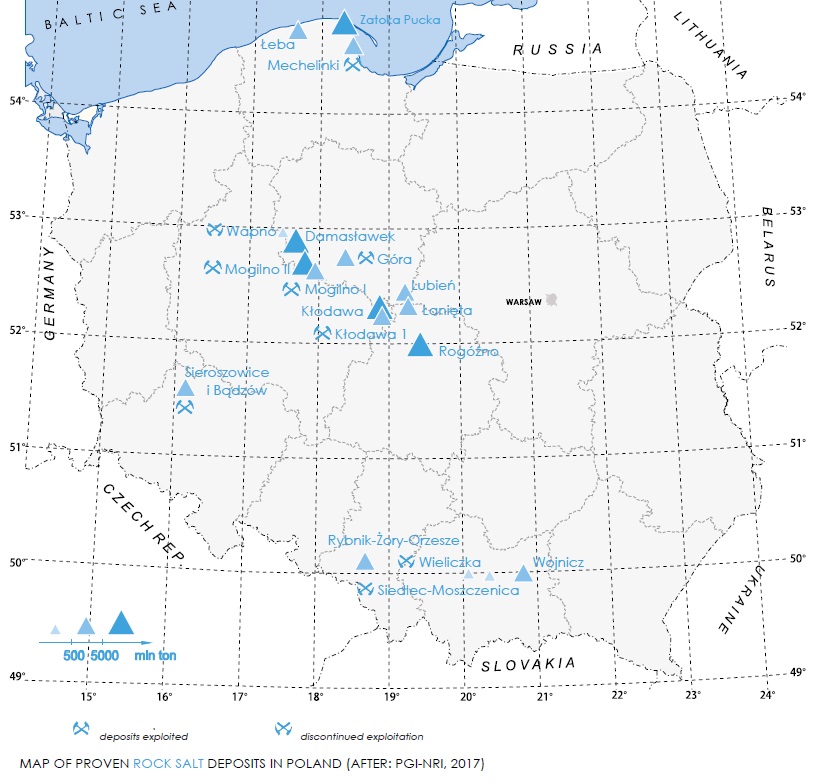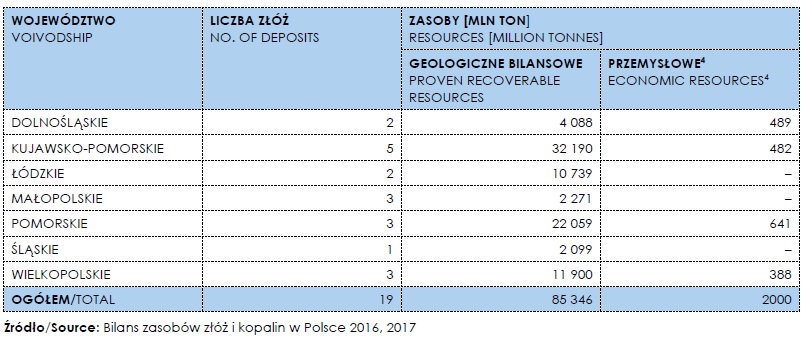There are 19 proven rock salt deposits in Poland, located within Zechstein and Miocene salt-bearing formations. As of 2015, the proven extra-pillar3 rock salt deposits were in excess of 85.4 billion tonnes.
Proven recoverable1 Zechstein salt resources account for 90% of the total domestic resources.
The resources of salt stratiform deposits are in excess of 26.1 billion tonnes and account for 30.6% of the total domestic salt resources, while the resources of salt diapir deposits have been estimated at approx. 54.9 billion tonnes, or 64.3% of the total domestic resources.
The Miocene salts are of minor importance in this context – the proven resources of these deposits amount to 4.36 billion tonnes, so that they account for only 5,1% of the total domestic salt resources.
Domasławek located in the Kujawsko-Pomorskie Voivodship is the largest deposit with approx. 17.7 billion tonnes of proven recoverable resources. The Zatoka Pucka (Puck Bay) salt bed deposit on the Baltic Sea holds the second largest resources in terms of surface area.

Poland’s proven rock salt resources are in excess of 107.5 billion tonnes. Moreover, estimates of predicted resources have been made for prognostic and prospective resources.
The predicted (prognostic5 and prospective6 combined) resources of the Zechstein rock salt amount to 4,052 billion tonnes. Prognostic and prospective resources to a depth of 2 km are estimated at over 944.8 and 3,037 billion tonnes, respectively.
The prognostic and prospective resources of the Miocene salt deposits are 6.49 and 270 billion tonnes, respectively.
The total of both proven and predicted rock salt resources is approx. 4,166 billion tonnes.

1 proven recoverable resources (anticipated economic resources) – resources in a deposit (or in a part thereof) of which natural characteristics meet the limit values of the parameters that define the deposit and enable resource recovery.
2 proven recoverable sub-economic resources – resources in a deposit that do not meet recoverability criteria and are in non-recoverable geological and mining conditions, but potentially can be mined in the future.
3 extra-pillar resources – anticipated economic resources excluding the deposit space that is required for the protection both the underground excavations and surface facilities against the consequences of excessive mining operations (protective pillars).
4 economic resources – part of anticipated economic resources that may be recovered in an economically viable way taking into account the environmental requirements.
5 prognostic resources – resources assessed on the basis of deposit structure and layout rules and preliminary geological surveys of a wider area:
- for salt stratiform occurrences at depths ≤1.2 km or folded salt bed occurrences in the Carpathian Fore-Deep Basin at depths ≤1.5 km,
- for salt diapir occurrences at depths ≤1.4 km.
6 prospective resources – resources assessed on the basis of deposit structure and layout rules and preliminary geological surveys of a wider area:
- for salt stratiform occurrences at depths >1.2–2.0 km,
- for folded salt bed occurrences in the Carpathian Fore-Deep Basin at depths >1.5–2.0 km,
- for salt diapir occurrences at depths >1,4–2.0 km.








